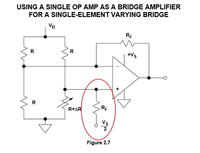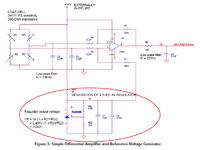dtomazini
Newbie level 5
Hi Everybody,
I'm new in this forum, and new to Op Amp.
A two weeks ago, I'm trying to build a simple weight measure project, using a load cell from a 10Kg kitchen scale and a PIC18F4550. My project did not work. But i don't understood what is going wrong.
Searching in this forum, and Google, i found lot information about load cells and Op Amps. But in almost cases, the op amp used like INA125, AD620, AD623 is hard to find and much expensive here in Brazil.
The first step in my project, is know the load cell that I'm using. For that i use a multimeter, to measure the resistance between connectors, and the voltage in load and unload:
Resistance in terminals:
"Excitation+" to "Excitation-" = 1K
"Signal+ " to "Signal -" = 1K
"Signal+ " to "Excitation-" = 750R
"Signal-" to "Excitation+" = 750R
Voltage (using a 5.45v power source) in terminals SIG+ and SIG-:
Without load: 0,001v
At full load 10kg: 0,055v
To confirm the measuring scale voltage, i repeat the test using a 9.4v power source, an result was:
Without load: 0,001v
At full load 10kg: 0,094v
So after this tests, the conclusive schematic for my load cell is:
Please, can someone tell if this schematic is correct ?. And presume the scale of 1mv/V ?.
The second step, was try to use a Op Amp in "Differential" to amplify the voltage between SIG and SIG- for the PIC18F4550 ADC module .
Now is the problem...I try a LOT of schemas, formulas, Inverting, Non-inverting, Differential, Differential Instrumental, etc... and have nothing.
In my lab (house), I have the following Op Amps:
Single:
UA741CN
TL081
OP07
LM318
LM301AN
Dual:
TL082
LM358
None of them work's as expected... or the voltage is saturated at 4.8v, or stuck in 1.28v, or simply did not respond for the load cell load alternations.
Tried Schematics:
Diferential Op Amp ("SIG+" - "SIG-"), Gain Vo/Vi = 10:
Similar project from this link: https://www.galant-e.ru/images/upload/1875/ru/an_651x_011%20-%20rev%201-3.pdf
I'm new in this forum, and new to Op Amp.
A two weeks ago, I'm trying to build a simple weight measure project, using a load cell from a 10Kg kitchen scale and a PIC18F4550. My project did not work. But i don't understood what is going wrong.
Searching in this forum, and Google, i found lot information about load cells and Op Amps. But in almost cases, the op amp used like INA125, AD620, AD623 is hard to find and much expensive here in Brazil.
The first step in my project, is know the load cell that I'm using. For that i use a multimeter, to measure the resistance between connectors, and the voltage in load and unload:
Resistance in terminals:
"Excitation+" to "Excitation-" = 1K
"Signal+ " to "Signal -" = 1K
"Signal+ " to "Excitation-" = 750R
"Signal-" to "Excitation+" = 750R
Voltage (using a 5.45v power source) in terminals SIG+ and SIG-:
Without load: 0,001v
At full load 10kg: 0,055v
To confirm the measuring scale voltage, i repeat the test using a 9.4v power source, an result was:
Without load: 0,001v
At full load 10kg: 0,094v
So after this tests, the conclusive schematic for my load cell is:
Please, can someone tell if this schematic is correct ?. And presume the scale of 1mv/V ?.
The second step, was try to use a Op Amp in "Differential" to amplify the voltage between SIG and SIG- for the PIC18F4550 ADC module .
Now is the problem...I try a LOT of schemas, formulas, Inverting, Non-inverting, Differential, Differential Instrumental, etc... and have nothing.
In my lab (house), I have the following Op Amps:
Single:
UA741CN
TL081
OP07
LM318
LM301AN
Dual:
TL082
LM358
None of them work's as expected... or the voltage is saturated at 4.8v, or stuck in 1.28v, or simply did not respond for the load cell load alternations.
Tried Schematics:
Diferential Op Amp ("SIG+" - "SIG-"), Gain Vo/Vi = 10:
Similar project from this link: https://www.galant-e.ru/images/upload/1875/ru/an_651x_011%20-%20rev%201-3.pdf

